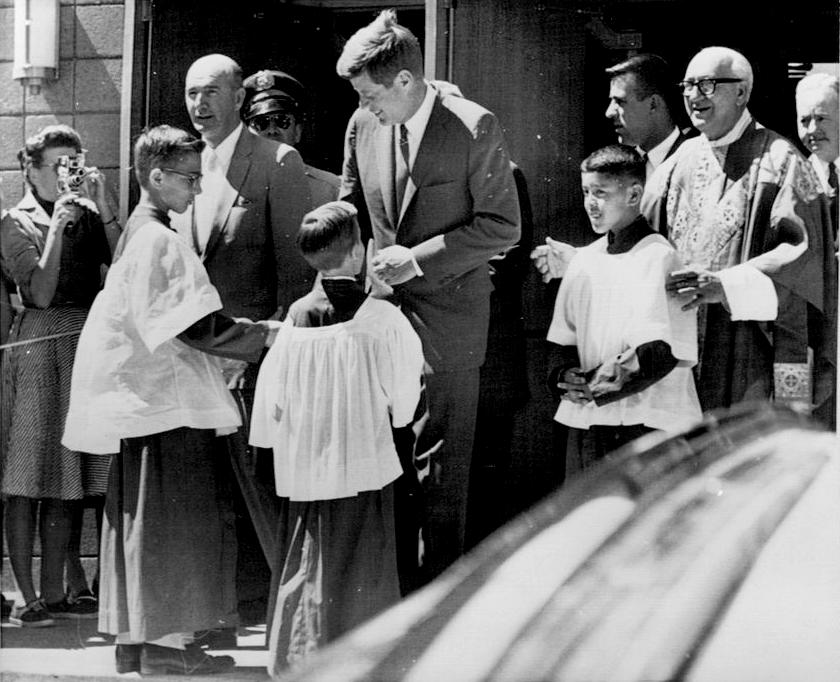
Catholocism in American Politics

Figure 1.--The Irish were the first Catholics to emigrate to largely Protesrant America in large numbers. Many more were to follow after the Civil War. They would soon begin to play aolitical role, being elected to loval offices and then bgovenors, Congressmen and senators. The presidency proved a barrier, largely because thecDEmocratic Party was split. The northern Democrtic Party relied on European Cathlic votres and other ethnic minorities to win election elections while the southern Democrats were staunchly anti-Catholic. President Kennedy finally cracked the solid South in 1960. Part of the reason he suceeded was hi stauncly anti-Communist positions and war record. Here he is as president in 1962. The press caption read, "President Greets Altar Boys: Three altar boys of the Sacred Heart Catholic ChurchatvnearbybPalm Desert, received an unexpected thrill this morningwhen President Kennedy left the church following mass.The President stopped to shake hands with each one from left Bill Hickelmann, 13, KevinMcGee, 10, ; and James Olguin, 11. Father Es=dwards, pastor, ar right, conducted the mass.
|
|
The United States was founded as a Protestant nation. Only Maryland had substantial numbers of Catholics. And Maryland was not one of the larger states. Ans there was not at first a high degree of trelgious toleration. This only changed because there was no single Protestant denomination. In fct there were so many Protestant dnominations that a high degree of religious toleration devloped in the north and considerable opposition to an established church developed in the South where the Angkicn Church if England was dominant. As a result, religious freedom was insjrined in the First Amendment of the Constitution. And this not only included choice of Christian denominations, but of any religion. But while religious freedom was established by the First Amendment, the vast majority of Americans were Protestants. And this meant that there was considerable fear of Catholics based on the English and uropean experience. Substantial numbers of Catholics did not begin arriving in America until the Irish Potato Famine (1840s). For three decades, the Irish were he only large group of Catholics. This did not begin to change until after the Civil War (1870s). Both Protesants and Catholics came, but Cathoics came in very large numbers, and this continued until World War I. Catholic immigrants came from Belgium, Czechoslovkia, Germany, Italy, Poland, Portugal, Slovena, Slovakia, and other countries. The largest group was Italians. The major concern was that Catholics held allegince to the Pope and not to the United States. Catholics beginning with the Irish tended to vote Democratic. This process began as the Democratic big city political machines very effectively coopted the immigrant communities. The Republican after the Civil War were inclined to adopt protectionist policies. There was suspicion of parochial schools. A good example is St. Joseph's school. Early labor unions tended to support Republicans because immigrant labor impaired their ability to demand higher wages. As a result of the Civil War the Southern states became solidly Demicratic. In the north the standard Republican slogan was to describe the Democrats as the party of 'rum, romanism, and rebellion'. Relativly few Catholics settled in the South, except for Lousiana. This made for a unstable Democratic coalitions. Democratic presidential candidates could not win without the South and the South would not vote for a Catholic candidate. The Democrats thus would not nominate canfidates from some of their major constiuencies. When they finally nominated a Catholic (Al Smith in 1928) it was a dusaster for the Party. President Roosevelt and the New Deal brought Labor into the Democratic coalition. The Democrats nominted another Catholic in 1960, Massachusetts senator John F. Kennedy. Vice President Nixon ordered his staff not to bring up the question of Kennedy's Catholicm. The final analysis of the election showed that Kennedy's religion ended up helping him more with Catholic voters than it then it hurt him with Protetant voters. Since the 1960 election, the Catholic vote has become ctitical in elections. And ironivally given the Protestant blief that Cathlics were disloyal, Catholics have become perhaps the most patriotic of all voter groups outside of evangelicals. Candidates fliert with ffailure id they do not gain the Catholic vote. Catholics tradutionally vote Denocratic because of the Party's success with ethnic minorities and supportvfrom Labor unions. Catholic voters can be won over as Presidents Eisenhower and Reagan showed. And patriotism has a special appeal to Catholic voters. It is not the only issue important to them, but it is an importnt one. And Mrs Clinton ignored this to her peril. Evagelical Protestants voted overealmingly for Trump in 2016, but Trump also carried Catholic voters, albeit by smaller numbers.
CIH

Navigate the Children in History Website:
[Return to the Main U.S. 1960 election campasign page]
[Return to the Main U.S. 1960 election page]
[Return to the Main U.S. 20th century election page]
[Return to the Main U.S. election page]
[Return to the Main U.S. presidential page]
[Return to the Main U.S. political party page]
[Return to the Main U.S. history page]
[About Us]
[Introduction]
[Biographies]
[Chronology]
[Climatology]
[Clothing]
[Disease and Health]
[Economics]
[Freedom]
[Geography]
[History]
[Human Nature]
[Ideology]
[Law]
[Nationalism]
[Presidents]
[Religion]
[Royalty]
[Science]
[Social Class]
[Bibliographies]
[Contributions]
[FAQs]
[Glossaries]
[Images]
[Links]
[Registration]
[Tools]
[Children in History Home]
Created: 6:17 AM 3/7/2017
Last edited: 6:17 AM 3/7/2017



